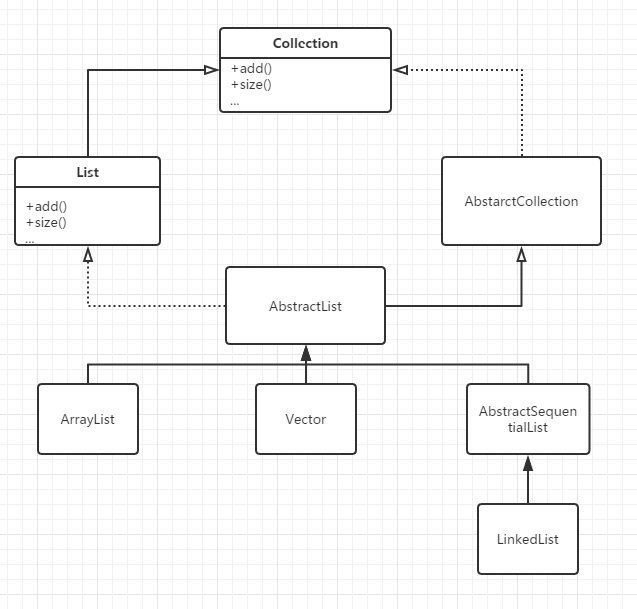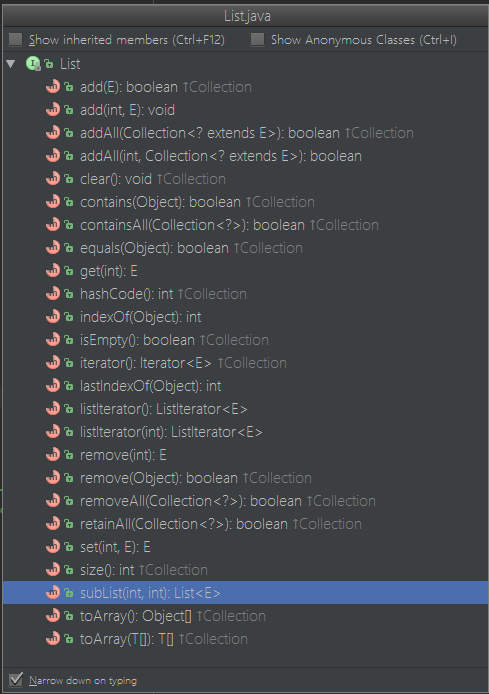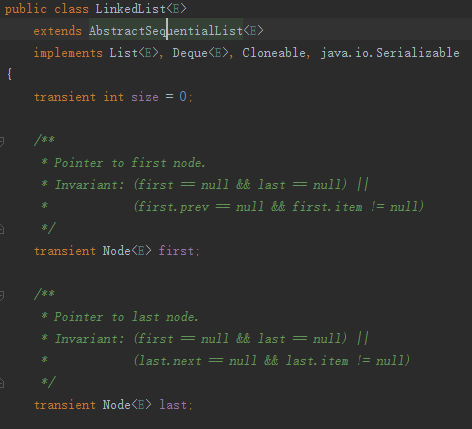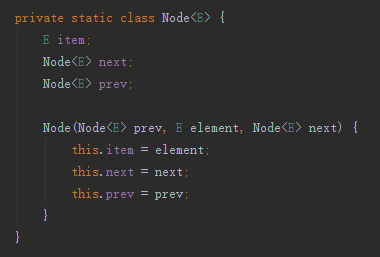简述
上章简单介绍了什么是集合,集合有哪几种种类。
在这章中我们主要介绍Collection的其中一种实现方式,List。
什么是List
在上一章,我们已经了解了List主要分为3类,ArrayList, LinkedList和Vector。
为了进一步清晰List的结构,我在这手工画了一张图,用于回顾下
AbstarctCollection在上一张Java集合详解–什么是集合已经有简单的介绍,它是Collection接口的部分实现
1.List接口
首先看下List的官方定义
这段描述解决了许多公司经常问的两个问题List有什么特点和Set有什么区别。
上面清楚的说明了List是一个有序的集合,和set不同的是,List允许存储项的值为空,也允许存储相等值的存储项,还举了e1.equal(e2)的例子。
List是继承于Collection接口,除了Collection通用的方法以外,扩展了部分只属于List的方法。
从上图可以发现,List比Collection主要多了几个add(…)方法和remove(…)方法的重载,还有几个index(…), get(…)方法。
而AbstractList也只是实现了List接口部分的方法,和AbstractCollection是一个思路,这里就不具体介绍了,有兴趣的同学可以自行研究下。
2.ArraryList
ArrayList是一个数组实现的列表,由于数据是存入数组中的,所以它的特点也和数组一样,查询很快,但是中间部分的插入和删除很慢。我们来看几段关键的代码。
首先是ArrayList的类关系和成员变量
//ArrayList继承了Serializable并且申明了serialVersionUID,表示ArrayList是一个可序列化的对象,可以用Bundle传递
public class ArrayList<E> extends AbstractList<E>
implements List<E>, RandomAccess, Cloneable, java.io.Serializable
{
private static final long serialVersionUID = 8683452581122892189L;
/**
* Default initial capacity.
*/
private static final int DEFAULT_CAPACITY = 10;
/**
* Shared empty array instance used for empty instances.
*/
private static final Object[] EMPTY_ELEMENTDATA = {};
/**
* The array buffer into which the elements of the ArrayList are stored.
* The capacity of the ArrayList is the length of this array buffer. Any
* empty ArrayList with elementData == EMPTY_ELEMENTDATA will be expanded to
* DEFAULT_CAPACITY when the first element is added.
*/
//从这里可以看到,ArrayList的底层是由数组实现的,并且默认数组的默认大小是10
private transient Object[] elementData;
/**
* The size of the ArrayList (the number of elements it contains).
*
* @serial
*/
private int size;
然后是构造函数
//ArrayList有2个构造函数,一个是默认无参的,一个是传入数组大小的
//在JavaEffect书中明确提到,如果预先能知道或者估计所需数据项个数的,需要传入initialCapacity
//因为如果使用无参的构造函数,会首先把EMPTY_ELEMENTDATA赋值给elementData
//然后根据插入个数于当前数组size比较,不停调用Arrays.copyOf()方法,扩展数组大小
//造成性能浪费
/**
* Constructs an empty list with the specified initial capacity.
*
* @param initialCapacity the initial capacity of the list
* @throws IllegalArgumentException if the specified initial capacity
* is negative
*/
public ArrayList(int initialCapacity) {
super();
if (initialCapacity < 0)
throw new IllegalArgumentException("Illegal Capacity: "+
initialCapacity);
this.elementData = new Object[initialCapacity];
}
/**
* Constructs an empty list with an initial capacity of ten.
*/
public ArrayList() {
super();
this.elementData = EMPTY_ELEMENTDATA;
}然后是add()操作
//首先看到,不过是指定index执行add操作,还是在尾部执行add操作,都会先确认当前的数组空间是否够插入数据
//并且从
//int oldCapacity = elementData.length;
//int newCapacity = oldCapacity + (oldCapacity >> 1);
//if (newCapacity - minCapacity < 0)
// newCapacity = minCapacity;
//看出,ArrayList默认每次都是自增50%的大小再和minCapacity比较,如果还是不够,就把当的
//size扩充至minCapacity
//然后,如果是队尾插入,也简单,就把数组向后移动一位,然后赋值
//如果是在中间插入,需要用到System.arraycopy,把index开始所有数据向后移动一位
//再进行插入
/**
* Appends the specified element to the end of this list.
*
* @param e element to be appended to this list
* @return <tt>true</tt> (as specified by {@link Collection#add})
*/
public boolean add(E e) {
ensureCapacityInternal(size + 1); // Increments modCount!!
elementData[size++] = e;
return true;
}
/**
* Inserts the specified element at the specified position in this
* list. Shifts the element currently at that position (if any) and
* any subsequent elements to the right (adds one to their indices).
*
* @param index index at which the specified element is to be inserted
* @param element element to be inserted
* @throws IndexOutOfBoundsException {@inheritDoc}
*/
public void add(int index, E element) {
rangeCheckForAdd(index);
ensureCapacityInternal(size + 1); // Increments modCount!!
System.arraycopy(elementData, index, elementData, index + 1,
size - index);
elementData[index] = element;
size++;
}
private void ensureCapacityInternal(int minCapacity) {
if (elementData == EMPTY_ELEMENTDATA) {
minCapacity = Math.max(DEFAULT_CAPACITY, minCapacity);
}
ensureExplicitCapacity(minCapacity);
}
private void ensureExplicitCapacity(int minCapacity) {
modCount++;
// overflow-conscious code
if (minCapacity - elementData.length > 0)
grow(minCapacity);
}
private void grow(int minCapacity) {
// overflow-conscious code
int oldCapacity = elementData.length;
int newCapacity = oldCapacity + (oldCapacity >> 1);
if (newCapacity - minCapacity < 0)
newCapacity = minCapacity;
if (newCapacity - MAX_ARRAY_SIZE > 0)
newCapacity = hugeCapacity(minCapacity);
// minCapacity is usually close to size, so this is a win:
elementData = Arrays.copyOf(elementData, newCapacity);
}然后是remove操作
//个人感觉整个remove操作的代码写了很冗余,不像甲骨文这些大神的风格
//首先来看remove(int index)
//先进行边界确认,传入的index是否超过了当前数组的大小,如果是抛出异常
//如果在数组范围内,就把index之后的数据整体向前移动一位,最后一位值清空
//如果是remove(Object o),传入的是一个对象,就会进行一次indexOf的操作,去当前数组中寻找
//判断是否存在,这里的代码就十分冗余了,就是把indexOf的代码拷贝了一次,完全可以调用indexOf方法
//根据返回值是否为-1来判断该值是否存在,如果存在就调用fastRemove方法
//fastRemove(int index)和remove(int index)方法除了边界检查一模一样
//完全可以在remove调用完rangeCheck(index)后调用fastRemove就可以了
//这里不是很明白设计者的意图
/**
* Removes the element at the specified position in this list.
* Shifts any subsequent elements to the left (subtracts one from their
* indices).
*
* @param index the index of the element to be removed
* @return the element that was removed from the list
* @throws IndexOutOfBoundsException {@inheritDoc}
*/
public E remove(int index) {
rangeCheck(index);
modCount++;
E oldValue = elementData(index);
int numMoved = size - index - 1;
if (numMoved > 0)
System.arraycopy(elementData, index+1, elementData, index,
numMoved);
elementData[--size] = null; // clear to let GC do its work
return oldValue;
}
/**
* Removes the first occurrence of the specified element from this list,
* if it is present. If the list does not contain the element, it is
* unchanged. More formally, removes the element with the lowest index
* <tt>i</tt> such that
* <tt>(o==null ? get(i)==null : o.equals(get(i)))</tt>
* (if such an element exists). Returns <tt>true</tt> if this list
* contained the specified element (or equivalently, if this list
* changed as a result of the call).
*
* @param o element to be removed from this list, if present
* @return <tt>true</tt> if this list contained the specified element
*/
public boolean remove(Object o) {
if (o == null) {
for (int index = 0; index < size; index++)
if (elementData[index] == null) {
fastRemove(index);
return true;
}
} else {
for (int index = 0; index < size; index++)
if (o.equals(elementData[index])) {
fastRemove(index);
return true;
}
}
return false;
}
/*
* Private remove method that skips bounds checking and does not
* return the value removed.
*/
private void fastRemove(int index) {
modCount++;
int numMoved = size - index - 1;
if (numMoved > 0)
System.arraycopy(elementData, index+1, elementData, index,
numMoved);
elementData[--size] = null; // clear to let GC do its work
}indexof
//这里就和上面remove寻找是一模一样的,就不进行探讨了
public int indexOf(Object o) {
if (o == null) {
for (int i = 0; i < size; i++)
if (elementData[i]==null)
return i;
} else {
for (int i = 0; i < size; i++)
if (o.equals(elementData[i]))
return i;
}
return -1;
}3.Vector
Vector就是ArrayList的线程安全版,它的方法前都加了synchronized锁,其他实现逻辑都相同。
如果对线程安全要求不高的话,可以选择ArrayList,毕竟synchronized也很耗性能
4.LinkedList
故名思意就是链表,和我们大学在数据结构里学的链表是一会事,LinkedList还是一个双向链表。
LinkedList继承于AbstractSequentialList,和ArrayList一个套路。内部维护了3个成员变量,一个是当前链表的头节点,一个是尾部节点,还有是链表长度。然后我们在来看下Node这个数据结构。
和C语言实现方式差不多,由于是双向链表,所以记录了next和prev,只不过把C语言里的指针换成了对象。
然后我们简单的在来看下链表额度查询,插入和删除操作
首先是add(E e)操作
//学过数据结构的同学看这部分代码特别轻松
//首先来看下void linkLast(E e),尾部插入
//就是把newNode的前面节点执行现在的尾部节点,newNode的后面节点执行null,因为是在尾部嘛
//然后把现在的尾部节点的后面节点指向newNode,因为现在的尾部节点不是最后一个了
//然后再来看下中间插入
//也是一个套路。假设现在在3号位插入一个newNode
//就是通过现在的3号Node的prev找到2号节点,然后修改2号节点的next,指向nowNode
//然后nowNode的prev指向2号节点,next指向3号节点
//最后3号节点的prev变成了nowNode,next不变
//这样就完成了一次中间插入
/**
* Inserts the specified element at the specified position in this list.
* Shifts the element currently at that position (if any) and any
* subsequent elements to the right (adds one to their indices).
*
* @param index index at which the specified element is to be inserted
* @param element element to be inserted
* @throws IndexOutOfBoundsException {@inheritDoc}
*/
public void add(int index, E element) {
checkPositionIndex(index);
if (index == size)
linkLast(element);
else
linkBefore(element, node(index));
}
/**
* Appends the specified element to the end of this list.
*
* <p>This method is equivalent to {@link #addLast}.
*
* @param e element to be appended to this list
* @return {@code true} (as specified by {@link Collection#add})
*/
public boolean add(E e) {
linkLast(e);
return true;
}
/**
* Links e as last element.
*/
void linkLast(E e) {
final Node<E> l = last;
final Node<E> newNode = new Node<>(l, e, null);
last = newNode;
if (l == null)
first = newNode;
else
l.next = newNode;
size++;
modCount++;
}
/**
* Inserts element e before non-null Node succ.
*/
void linkBefore(E e, Node<E> succ) {
// assert succ != null;
final Node<E> pred = succ.prev;
final Node<E> newNode = new Node<>(pred, e, succ);
succ.prev = newNode;
if (pred == null)
first = newNode;
else
pred.next = newNode;
size++;
modCount++;
}然后是void linkLast(E e)操作
//indexOf操作非常简单,就是从头开始遍历整个链表,如果没有就反-1,有就返回当前下标
/**
* Returns the index of the first occurrence of the specified element
* in this list, or -1 if this list does not contain the element.
* More formally, returns the lowest index {@code i} such that
* <tt>(o==null ? get(i)==null : o.equals(get(i)))</tt>,
* or -1 if there is no such index.
*
* @param o element to search for
* @return the index of the first occurrence of the specified element in
* this list, or -1 if this list does not contain the element
*/
public int indexOf(Object o) {
int index = 0;
if (o == null) {
for (Node<E> x = first; x != null; x = x.next) {
if (x.item == null)
return index;
index++;
}
} else {
for (Node<E> x = first; x != null; x = x.next) {
if (o.equals(x.item))
return index;
index++;
}
}
return -1;
}虽然indexOf非常简单,但是我在这还是写了个例子,帮助大家理解下
List list = new ArrayList();
list.add("zero");
list.add(null);
list.add("two");
list.add(null);
list.add("three");
Log.i("test", "index : " + list.indexOf(null));在不看答案的情况下 大家能准确的说出答案吗?
Answer:I/test: index : 1
从这个例子可以看出三点List的特征
1.是按顺序查找
2.允许存储项为空
3.允许多个存储项的值相等
最后看下remove操作
//如果直接调无参的remove(),就会默认删除头节点
//删除头节点非常简单,就是把头节点的值清空,next清空
//然后把nextNode只为头节点,然后清空next的prev
//最后size减1
//如果是删除中间节点,调用remove(int index)
//首先判断Index对应的节点是否为头节点,即index是否为0
//如果不是中间节点,就是x的prev指向x的next
public E remove() {
return removeFirst();
}
public E remove(int index) {
checkElementIndex(index);
return unlink(node(index));
}
public E removeFirst() {
final Node<E> f = first;
if (f == null)
throw new NoSuchElementException();
return unlinkFirst(f);
}
private E unlinkLast(Node<E> l) {
// assert l == last && l != null;
final E element = l.item;
final Node<E> prev = l.prev;
l.item = null;
l.prev = null; // help GC
last = prev;
if (prev == null)
first = null;
else
prev.next = null;
size--;
modCount++;
return element;
}
/**
* Unlinks non-null node x.
*/
E unlink(Node<E> x) {
// assert x != null;
final E element = x.item;
final Node<E> next = x.next;
final Node<E> prev = x.prev;
if (prev == null) {
first = next;
} else {
prev.next = next;
x.prev = null;
}
if (next == null) {
last = prev;
} else {
next.prev = prev;
x.next = null;
}
x.item = null;
size--;
modCount++;
return element;
}
/**
* Unlinks non-null first node f.
*/
private E unlinkFirst(Node<E> f) {
// assert f == first && f != null;
final E element = f.item;
final Node<E> next = f.next;
f.item = null;
f.next = null; // help GC
first = next;
if (next == null)
last = null;
else
next.prev = null;
size--;
modCount++;
return element;
}
总结
通过上面对ArrayList和LinkedList的分析,可以理解List的3个特性
1.是按顺序查找
2.允许存储项为空
3.允许多个存储项的值相等
可以知其然知其所以然
然后对比LinkedList和ArrayList的实现方式不同,可以在不同的场景下使用不同的List
ArrayList是由数组实现的,方便查找,返回数组下标对应的值即可,适用于多查找的场景
LinkedList由链表实现,插入和删除方便,适用于多次数据替换的场景
再下一章中,我们可以了解set是如何实现的,还有set又有哪些特性


























 309
309











 被折叠的 条评论
为什么被折叠?
被折叠的 条评论
为什么被折叠?








